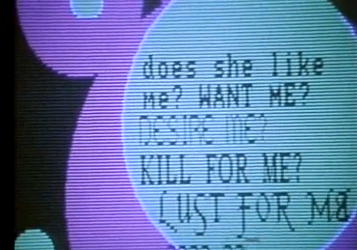Cyberfeminism Index is INCOMPLETE and ALWAYS IN PROGRESS. Commissioned by Rhizome, it premiered with New Museum’s First Look. The printed publication Cyberfeminism Catalog will be published by Inventory Press in 2022. Please feel welcome to contribute using the “submit” button at the bottom of all pages.
cyberfeminism?
Cyberfeminism cannot be reduced to women and technology. Nor is it about the diffusion of feminism through technology. Combining cyberand feminism was meant as an oxymoron or provocation, a critique of the cyberbabes and fembots that stocked the sci-fi landscapes of the 1980s. The term is self-reflexive: technology is not only the subject of cyberfeminism, but its means of transmission. It’s all about feedback.
Rooted as it is by feminism, cyberfeminism is an imperfect umbrella term. The history of feminism is dominated by Western attitudes, which makes it complicated and exclusionary. The reason I have chosen to use the term is because the combination of ‘cyber’ and ‘feminism’ allows novices to quickly connote its meaning and speaks to its lineage and evolution. This includes branches like Cyberfeminism 2.0 (316), black cyberfeminism (404), xenofeminism (536), post-cyber feminism (486), glitch feminism (343), Afrofuturism (16), and hackfeministas (555), transhackfeminism [page «Becoming machine-witch-plant Gynaecological TransHackFeminism and joyful dystopia» not found], 넷페미 (netfemi) (464), 女权之声 (feminist voices) (560), among others.
When I began building this index, Judy Malloy (210) recommended that I distinguish between YACK or HACK, theory versus practice respectively. YACK was collected by reading. HACK was collected through conversations with generous people who told me their stories and referred me to others (see below for these contributors). I learned of hackerspaces (456), digital rights activist groups (15), DIWO organizations (527), DIY teledildonics manuals (498), bio-hacktivists (384), data dominatrixes (491), and open source estrogen pioneers (481).
The majority of references I received and read drew from a Western context. This may have been due to the limits of English, but it may also have been the relatively late adoption of the internet and varying forms of feminism outside the West. It may have also been the difference in terminology and search queries, as many included here do not self-identify as cyberfeminist. The voids in this index should not suggest that non-Western cyberfeminism does not exist. They merely reveal the inherent constraints of my Western vantage.
design
Angeline and I actively thought about how websites age… Many of the design elements use default form fields and system fonts, like Arial by Robin Nicholas and Patricia Saunders, one of few system fonts designed by a woman. The website was inspired by the First Cyberfeminist International website (91) by Old Boys Network (88). In order to future proof this website, Angeline used the least amount of extra tech as possible, such as vanilla JavaScript for client-side and only Python for server-side. There is one additional library used for markdown, but other than this, we do not rely on third parties or additional libraries and plugins. One day, it will be incorporated into Rhizome’s linked open data project Artbase.
submit
I’m actively reaching out to different people for references (cited at the bottom of each entry, respectively) and I hope that one day this index can truly reflect the global nature of the cyberfeminist movement. While I have initiated this collection, its use and longevity will depend on its collaborative editing and compilation. Please feel welcome to contribute using the “submit” button at the bottom of all pages.
credits
Cyberfeminism Index is facilitated and gathered by Mindy Seu. The website was designed in collaboration with and developed by Angeline Meitzler, with frontend support from Janine Rosen and PDF support from Charles Broskoski. The typeface is Arial by Patricia Saunders and Robin Nicholas. Using their metrics, Laura Coombs designed the encircled cross-reference numbers to make a complementary pairing.
All entry descriptions are excerpts from existing texts (abstracts, website about pages, essay excerpts, manifesto transcriptions); please refer to the credit at the bottom of each quote. Feedback and entries were collected through on-site and online meetings with generous people, including (in alphabetical order by last name): Melissa Aguilar, Chinmayi Arun, Cyborgrrrls, Salome Asega, Matthew Battles, Inés Benitez, Berkman Klein Center for the Internet & Society, Kelsey Brod, Agnes Cameron, Ruth Catlow, Soyoung Chong, Michael Connor, Sasha Costanza-Chock, Jessica Dheere, Brenda Dvoskin, Dragan Espenschield, Laura Forlano, Sarah Fox, Loraine Furter, Mariel García-Montes, Sal Hamerman, Geoff Han, Sam Hart, Melanie Hoff, Dragana Kaurin, Hanna Kim, Levin Kim, Malin Kuht, Fei Liu, Mary Maggic, Judy Malloy, Shannon Mattern, Amye McCarther, Jasmine McNealy, Christine Meinders, Angeline Marie Michael Meitzler, MetaLab Harvard, Eric Moed, Sarah Newman, Chiara Fauda Pichet, Constanza Piña, David Reinfurt, Kalli Retzepi, Refresh Tech, Rhizome, Paola Ricaurte, Lozana Rossenova, Dorothy Santos, Andrew Scheinman, Jeffrey Schnapp, Laurel Schwulst, Boaz Sender, Malkit Shoshan, Caroline Sinders, Hee-jeong Sohn, Cornelia Sollfrank, Abby Spinak, Salome Viljoen, Charlotte Webb, Faith Wilding, Xin Xin, Gary Zhexi Zhang. I’ve tried to note the respective contributions by adding names to each entry. If any of these were incorrectly cited, please feel welcome to contact me.
(cc) Everything written by me, Mindy Seu, on this page is licensed under the Creative Commons Attribution-Noncommercial 3.0 United States License. You don’t need to ask to use it, but please give credit! To cite entries in the index, please refer to their permissions.
More credits! Laura Coombs also noticed adrienne maree brown’s use of “gathered” to describe her role in Pleasure Activism. The description above was excerpted and edited from the May 2019 draft version of Cyberfeminism Catalog written by myself and edited by Andrew Scheinman.
back to top contact submit
